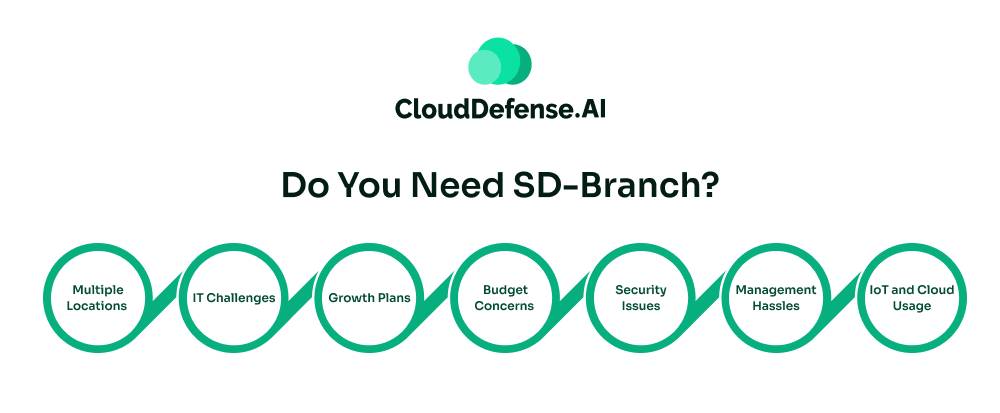What is Secure SD-Branch?
SD-Branch, or Software Defined Branch, is an all-in-one solution for managing branch networks. It is a smart way to manage all the tech at different office locations.
Basically, it combines a few key things:
- SD-WAN (that’s software-defined wide area networking)
- Network security features
- LAN (local area network) management
- Wi-Fi control
To better understand SD-Branch, let’s break down its key components as illustrated in a typical setup:
- User: This represents an end-user in the branch office, using devices like laptops or smartphones.
- Access Point: This is the Wi-Fi access point that provides wireless connectivity within the branch office. In an SD-Branch setup, these access points are centrally managed and can be easily configured.
- Switch: This network switch connects various devices within the branch office. In SD-Branch, these switches are software-defined, allowing for easier management and configuration from a central location.
- Branch Gateway: This crucial component manages traffic, applies policies, and connects the branch to the wider network and internet. It often incorporates SD-WAN functionality.
- Security: Integrated security features provide protection at the network edge.
The whole point is to make everything work together smoothly and securely. Here’s the deal: Instead of having a bunch of complicated IT stuff at each branch, SD-Branch uses software to handle most of the work. This means setting up a new branch is way easier and cheaper than it used to be. In fact, it’s so straightforward that someone at the branch could probably set it up themselves without needing an IT expert to fly in.
One of the cool things about SD-Branch is that it gives people working at branches the same level of secure access as if they were at the main office. This is super helpful, especially now that so many people are working remotely.
Another big plus is how it handles IoT devices. You know how there are more and more smart devices in offices these days? Well, Secure SD-Branch helps keep all those devices in check and makes sure they don’t cause security problems.
It’s also really good at dealing with cloud stuff. Since a lot of companies are using more SaaS (Software as a Service) products, Secure SD-Branch includes features to protect against data loss, theft, and malware.
All in all, it’s a pretty smart way for companies to keep their branch networks running smoothly and securely without spending a ton of money or time on complicated setups.
SD-WAN vs. SD-Branch: Key Differences
SD-WAN came first and has been around for a while now. It’s all about making wide-area networks (the WAN part) easier to manage using software. Basically, it helps companies connect their different locations more efficiently.
Now, SD-Branch is like SD-WAN’s modern version. It takes the ideas from SD-WAN and applies them to the whole branch office setup, not just the network connections.
Here’s a table summarizing the key differences:
| Feature | SD-WAN | SD-Branch |
| Focus | Optimizing WAN connections | Managing entire branch network |
| Core Technology | Software-Defined Networking (SDN) | SDN + Additional Branch functionalities |
| Key Features | Traffic management, cost optimization | Traffic management, cost optimization, security, Wi-Fi management, LAN control |
| Security | Basic security features, often requires additional solutions | Comprehensive integrated security for the entire branch |
Why is SD-Branch Crucial?

Simplifies Branch Setup
Setting up a new branch office used to be a real headache. You’d need IT experts to come in, set up a bunch of different systems, and make sure everything worked together. With SD-Branch, it’s way simpler. You can often just plug in one device, and it handles pretty much everything. This means companies can open new branches faster and with less hassle.
Saves Money
SD-Branch can help companies save a lot of cash. You don’t need as much hardware, and you can often manage everything remotely. This means fewer on-site IT staff and lower equipment costs. Plus, because it’s easier to set up, you save on those initial installation costs too.
Better Security
With more people working remotely and more devices connecting to networks, security is a big concern. SD-Branch typically comes with built-in security features that protect the whole branch network. It’s like having a security guard that watches over everything – from Wi-Fi to Internet of Things devices.
Easier Management
Imagine being able to control all your branch offices from one central location. That’s what SD-Branch offers. IT teams can see what’s happening across all branches, make changes, and fix problems without having to be physically present. It’s a huge time-saver.
Improves Performance
SD-Branch can make networks run smoother and faster. It can prioritize important traffic, so things like video calls or critical applications always get the bandwidth they need. This means happier employees and better productivity.
Future-Proof
Technology changes fast, and SD-Branch is designed to keep up. It’s flexible, so it can adapt to new technologies as they come along. This means companies don’t have to worry about their branch networks becoming outdated anytime soon.
What makes up an SD-branch setup?

Network Connection
First off, you’ve got the network connection. This is usually some kind of SD-WAN setup that connects the branch to the main office and the internet. It’s like the highway that all the branch’s data travels on.
Security
Next, there’s the security bit. This isn’t just a simple firewall anymore. SD-branch usually includes a next-gen firewall, intrusion prevention, and sometimes even things like malware scanning. It’s basically a bouncer for your network, keeping the bad stuff out.
Wi-Fi
Of course, you need Wi-Fi in a modern office. SD-branch setups typically include managed Wi-Fi access points. These are smarter than your average router – they can handle things like guest networks and prioritize important traffic.
LAN Switching
This is the part that connects all the devices in the office. In an SD-branch setup, these switches are usually managed from the same central console as everything else. It makes it way easier to keep track of what’s connected and control access.
IoT Management
With all the smart devices popping up in offices these days, SD-branch often includes tools to manage Internet of Things devices. This helps keep those potentially risky gadgets in check.
Central Management Console
This is where it all comes together. There’s usually a cloud-based management system where IT folks can control everything we just talked about. It’s like a control center for all your branches.
The cool thing about SD-branch is that all these parts are designed to work together smoothly. In the past, you might have had different systems for each of these things, but SD-branch packages it all up in one integrated solution.
Do You Need SD-Branch?

Figuring out if you need SD-Branch isn’t always straightforward. Let’s break it down into a few points to help you decide:
Multiple Locations
First off, do you have more than one office or store? If you’re running a single location, SD-Branch might be overkill. But if you’ve got several branches, it starts to make a lot more sense.
IT Challenges
Are you constantly struggling with IT issues at your branches? If you’re always sending IT staff to fix problems or your branch employees are always complaining about tech issues, SD-Branch could be a game-changer.
Growth Plans
Think about where your business is headed. Planning to open more locations soon? SD-Branch can make that expansion a lot smoother and faster.
Budget Concerns
Take a look at what you’re spending on branch IT. If you’re shelling out a lot for hardware, travel costs for IT staff, or dealing with frequent downtime, SD-Branch might actually save you money in the long run.
Security Issues
Concerned about keeping all your branches secure, especially with more remote work happening? SD-Branch typically comes with robust security features that could ease your mind.
Management Hassles
If managing all your branch networks feels like herding cats, SD-Branch’s centralized management could be a big help.
IoT and Cloud Usage
Are you using more smart devices or cloud services at your branches? SD-Branch is designed to handle these modern tech trends better than traditional setups.
Basically, if you’re nodding your head to several of these points, it might be worth looking into SD-Branch. It’s not a one-size-fits-all solution, but for many businesses with multiple locations, it can solve a lot of headaches.
Final Words
The future of SD-Branch looks pretty exciting. As more businesses spread out and embrace remote work, this tech is likely to become even more popular. We’ll probably see it get smarter, with more AI and machine learning to handle network issues automatically. Security will keep improving, too, adapting to new threats as they pop up.
One big trend to watch is how SD-Branch will work with 5G. As 5G networks roll out, SD-Branch will likely incorporate this tech to offer even faster, more reliable connections for branch offices.
We might also see SD-Branch solutions become more user-friendly, making it possible for even smaller businesses to take advantage of this tech. All in all, SD-Branch is set to play a big role in how companies manage their networks in the coming years.







